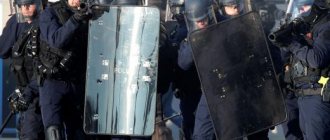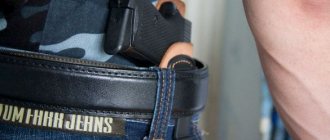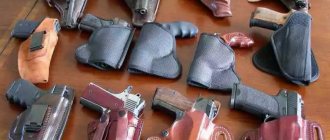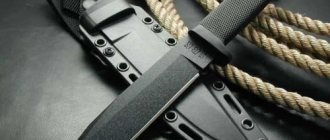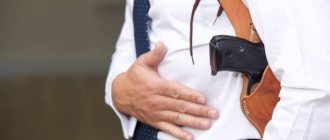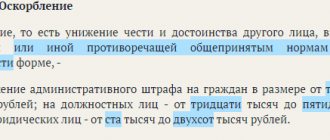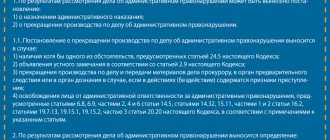According to the currently relevant legislation of our state, citizens have the right to use various weapons as means of self-defense. These include gas or powder sprayers, light and sound weapons, stun guns and, of course, traumatic weapons.
Basic information
The legislation of the Russian Federation allows the use of traumatic weapons in public places along with shockers, sprays and other means of self-defense. However, there is a list of situations in which you cannot carry such a weapon:
- rallies, demonstrations, public holidays;
- churches;
- educational institutions (except for military educational organizations and other similar institutions);
- cinemas, restaurants, bars;
- shopping centers.
Such restrictions do not affect people who are officially responsible for ensuring the order and security of such places and events.
The characteristics of traumatic weapons include the following:
- “drum” capacity – up to 10 rounds;
- maximum muzzle energy when fired – <91 J;
- used only for self-defense and exclusively with traumatic cartridges.
Most often in Russia, firearms of limited destruction are used - for example, a pistol, a barrelless device. Sometimes smooth-bore firearms with traumatic cartridges are used.
You cannot carry traumatic weapons in Russia in 2021 without permission.
Compliance with the rules for using LLC
The following rules for storing and carrying traumatic weapons are relevant for 2021. If permission is granted, please remember that:
- Additional devices - installation of silencers and night vision devices on traumatic weapons is prohibited;
- Where not to wear. Carrying traumatic weapons in public places (restaurants, cafes, medical and educational institutions) is unacceptable. The exception to these rules applies to security guards;
- Wearing OOOP is prohibited for those who are intoxicated. In this case, the fact of using a traumatic weapon is not necessary; for the onset of liability, it is enough for a drunk person to have it with him;
- How many pieces can you have? You can use only 2 (two) units of weapons with traumatic effects;
- In what form to have it with you. Legally carrying a traumatic weapon means that its owner has the weapon on with the safety on and without chambering a cartridge. If the traumatic weapon is long-barreled, then it must be carried unsheathed, while short-barreled weapons must be carried in a holster;
- Weapons can only be used in defensive situations: in case of danger, first fire a shot in the air and only then can you use the weapon to neutralize the attacker;
- Storage. The owner of a weapon is obliged to store it in a safe specially designed for this purpose.
Simply having a safe is not enough to meet all gun storage requirements. The owner ensures that the traumatic device is not accessible to anyone living in the house. In the event of your absence at home, family members should not present “injuries” to an employee of the Russian Guard, otherwise an administrative offense will occur.
How to obtain permission to carry a traumatic weapon
A person over 21 years of age can obtain a license.
The procedure for obtaining a license is as follows.
- Pass a medical examination. You must contact a public hospital that is authorized to issue certificates in form 046-1 . You will need to make an appointment with a therapist, psychiatrist, narcologist and ophthalmologist. Passing a medical examination requires payment. The validity period of the completed certificate is 1 year.
- Take a paid training course when using weapons. It is necessary to enroll in an educational institution that is authorized to conduct such exams - information about such institutions can be found in the Department of Internal Affairs. On average, the course costs 5-7 thousand rubles , its duration is 12-15 hours. The course is devoted to how to buy a weapon, use it, and what penalties you may face for carrying a weapon without a license. At the end of the course there are practical exercises.
- Send an application to the licensing department of the police at your place of residence.
The application will need to include the following information:
- personal information about the applicant: full name, date of birth, residential address;
- purpose of purchasing a weapon;
- weapons storage location;
- date of compilation, signature.
Application for a permit to store and carry firearms.docx
The following documents are attached to the application:
- photocopy of passport;
- photo 3x4 format;
- a receipt confirming payment of the state duty (its amount is 100 rubles);
- certificate establishing no criminal record.
The application is reviewed within 10-14 days. During this period, the applicant will be informed of the need to come to the same department to obtain a license. Its validity period is 5 years.
In order to renew the permit for another 5 years, you must contact the LRO 3 months before its expiration date. If you go to the institution later, the staff will refuse to renew your permit.
The package of documents is similar, but there is no need to take the training course again.
What documents are needed to obtain a permit?
To obtain a personal injury license you must submit:
- an application drawn up in a standard approved form;
- a copy of the passport or an identity card that replaces it;
- two 3x4 photo cards;
- a check from the bank's cash desk confirming payment of the state duty.
In turn, to obtain a permit for a traumatic weapon, you will need:
- certificate of training completed and exam passed;
- medical certificate 046-1;
- an act from the local police commissioner confirming the presence in your residential premises (at your place of registration) of a safe or a special cabinet for storing a pistol;
- check from the bank office for payment of the duty.
Before applying for a permit, you will have to spend time and money on training in an accredited organization, undergo a medical examination, buy and install a cabinet / safe that is firmly attached to the wall and locked with a combination lock, and contact the local police officer to come to the owner of the injury and executed the said act.
A traumatic pistol, and under it - a certificate: the exam has been passed
Grounds for refusal to issue a license
A person will be denied a permit if the following circumstances are identified:
- applicant's age – up to 21 years;
- there are contraindications due to health or well-being;
- the relevant exam was not passed;
- no permanent place of residence;
- the applicant has violated hunting regulations in the past and received corresponding orders;
- the person who applied is subject to a conviction for any intentionally committed crime (but if the criminal record has expired or it was canceled early, a license will be issued);
- the person, within a year before applying for a license, committed at least two administrative offenses, violating public or administrative order;
- the applicant is serving a prison sentence (the type of crime is not important, even if it was committed accidentally);
- The applicant applied for a license when the 1-year validity period of the medical certificate had already expired.
At the same time, in case of an unreasonable refusal to issue a license, the applicant has the right to appeal this decision of the LRO employees by going to court. At the same time, judicial practice contains almost no cases of appeals for these reasons. The legislation establishes an exhaustive list of requirements for the applicant.
License
To obtain permission to purchase a weapon, a citizen must go through several mandatory steps:
- Attend preparatory courses for a certain time, and then pass simple practical and theoretical exams - first at school, then at the Ministry of Internal Affairs.
- Fill out an application for a license yourself or with the help of an employee. The form is issued by an authorized body; you can download it on the Internet.
- Attaching to the application a copy of your passport, a certificate from 002-о/у (signed by a therapist, ophthalmologist, narcologist and psychiatrist), a receipt for payment of the state fee and a photograph measuring 3x4 centimeters, come to the department to submit the document.
The decision to issue a permit must be made before the expiration of the 10-day period. In case of delay or unjustified refusal, a citizen has the right to challenge the unlawful actions of the body in court.
Grounds for refusal, in addition to failure to comply with one of the requirements listed above, may include a criminal conviction or the commission of antisocial administrative offenses. In this case, you will have to wait until your criminal record is expunged before applying again.
Carrying a traumatic weapon without permission: responsibility
For failure to comply with the rules for the purchase, storage and use of traumatic weapons, a person faces administrative liability.
- If a person violates the rules for storing or carrying weapons, he will have to pay a fine of up to 2 thousand rubles. Authorized persons will take away the weapon along with the ammunition - they will be given to the owner only if he eliminates all identified violations.
- If a person illegally buys, uses or stores a traumatic weapon without obtaining a license, then he pays a fine of 3-5 thousand rubles. The weapon and ammunition are taken away forever. The violator also risks facing administrative arrest.
- If a person’s license turns out to be expired, then he faces either a warning or a fine of 3 thousand rubles.
Attention! Russian legislation does not provide for criminal liability for violating the rules on traumatic weapons.
When is permission not required?
According to the law of the Russian Federation, not all types of self-defense firearms can be used only if you have the appropriate document. So, you can purchase without special permission:
- an air pistol with a caliber of no more than 4.5 mm;
- OOOP with power up to 7.5 J;
- signaling device;
- gas or pepper spray;
- stun gun
Important! Light and noise weapons (signals) can be used without a license only if their characteristics do not correspond to combat ones, that is, they cannot kill with them. Every citizen of the Russian Federation who has reached the age of majority has the right to buy a means of self-defense without permission from the relevant authorities.
Additional features and nuances
1. People who are under the influence of alcohol or drugs are not allowed to carry weapons. Thus, many drugs are not eliminated from the body for several weeks. If authorized persons detect traces of such substances in the blood of an armed person, he will be deprived of weapons, the right to own them, and will also receive a fine.
2. If a person is traveling by car, then the traumatic weapon can be carried separately from the cartridges in a case or on oneself when loaded. If he is on a train or subway, then only transportation of weapons is allowed - carrying is prohibited. And before flying, you must first contact the company and find out whether a person with a weapon will be accepted on a particular flight. For example, Pobeda stopped accepting passengers with weapons. Registration of a weapon takes a lot of time: the police will pick it up and release it to the owner only upon arrival back.
3. If the police ask to show a weapon along with documents for it, then first the owner needs to clearly warn the officer that he will now take it out (if you suddenly take out the barrel and start waving it, the person can be shot), and then slowly take it out without pointing it at the policeman's side.
Shooting from traumatic guns
The law does not clearly explain what situation can be considered critical when there is an urgent need to use weapons. In practice, it is difficult to prove that the use of trauma was necessary, and if the attacker also received bodily injuries, then a criminal case is opened against the defender. You can try to formulate rules for the use of traumatic weapons, immediately consulting with experts and lawyers. Let us remind you in advance that there are no such rules in the law, but from judicial practice it becomes clear how the owner of a weapon should behave so as not to change places with the aggressor.
Step 1: Warning. In America they say that if you take out a weapon, you need to shoot. This saying does not contradict their laws; it has a rational grain, since to ensure their safety everyone must be morally prepared to fire a shot. Otherwise, the sight of an inactive weapon will only anger the aggressor, and the outcome may become more disastrous. But our laws do not accept this approach.
Before opening fire, the defender is obliged to warn the aggressor about this. How can this be done? Unfortunately, the law does not specify the procedure, but the attempts made will be taken into account during the proceedings. Therefore, you should express your intentions repeatedly. This includes phrases, warnings, jerking the shutter, and finally, a shot in the air. Note that there is often not enough time for warnings, since every second counts. Injuring an enemy will certainly entail criminal liability, therefore, having picked up a weapon, everyone must make their choice ahead of time.
Step 2. Shooting from a traumatic pistol. If we consider the law, we may encounter a paradox in which the criminal has more rights than the defender. The main rule of shooting, as a reminder, is formulated and written on the cartridge packaging. You cannot shoot from a distance of less than one meter, and you cannot aim at the head and neck. Otherwise, your actions will be regarded as intentional. The owner of a traumatic gun has a difficult choice in winter, when the enemy is wearing a thick jacket or other piece of outerwear. All that remains is to shoot at the legs or unprotected parts of the arms. Here you will need to demonstrate your skills. In summer, the affected area is much wider. Exceptions are the head, neck and groin.
Step 3. Notification of competent authorities. Any case of use of a traumatic weapon should be reported to the police immediately. According to the law, a day is allotted for this, but your quickness can play into your hands. In parallel with waiting, the police will have to carry out a number of other measures to protect themselves.
- If injured, the victim should be provided with emergency medical care and an ambulance should be called. If the enemy tries to hide, you need to remember his appearance.
- It is advisable to take a position in which your actions will be recorded on a video camera, of which there are now many near shops, shopping centers and other establishments. If there is no camera, then after the incident is resolved, you should photograph the area.
- Try to convince passersby to participate as witnesses and wait for the police to arrive.
- You must not touch the cartridges after firing.
Step 4. Primary explanations. This step is considered the most difficult, as it can be decisive in the case. You should not expect that the police will immediately treat you as a victim. For them, the situation is obvious - you used a weapon and caused harm to a person’s health, which means you are the culprit. You must write an explanation, and in your own hand. All tips from operatives may have double standards, so it is better to refuse them. If a police officer records a statement from your words, then carefully re-read the contents before signing. If there are any comments, they should be indicated in the same document. The police may be against it, but that is your right. Be sure to indicate exactly what the threat to your life was. When you visit the police department again, hire a lawyer. You shouldn't hope that you're right.
Registration of permission
Application for a license to store and carry weapons
Let's look at how to obtain a permit to carry a traumatic weapon in 2021.
To obtain a permit to carry a weapon, you need to be patient - the process of collecting documents, reviewing the application and issuing a license can take several months.
The first step in registration is to contact the local police department, whose employees will tell you which service you need to contact.
Before going to the licensing department, you need to decide on the type of weapon - each type requires a specific license. Then you need to purchase a safe to store the pistol - having a safe will increase the chances of a positive verdict from the licensing commission.
After this, you need to contact the service that issues weapons licenses with a package of collected documents and wait for a decision. After approval of the permit, you will have to pay the state fee and pick up the document.
Why call the local police officer?
In the Russian Guard you will need to present the act drawn up by your local police officer. He will write it after examining the safe (or a special metal box, which is cheaper, but still possible).
You will definitely have to buy one - without it you will not only be allowed to legally store the TP, but even to purchase it. A homemade one will not work, you only need a factory one, with walls no thinner than 2 mm.
You will need to store both the pistol and ammunition in it. By the way, you can buy as many of them as you like, but don’t throw away the documents from the store. And in a trauma case, if you take it with you, there can only be 10 rounds of ammunition.
Who will not be granted permission by default?
There is a certain circle of people who cannot exercise their right to personal self-defense with the help of non-lethal weapons due to the following reasons:
- The applicant is under 21 years of age;
- The applicant is registered in a psychoneurological and narcological dispensary;
- Deviations in mental development;
- Alcohol or drug addiction;
- Epilepsy or other serious illnesses that interfere with the full possession and maintenance of weapons;
- Severe health impairments associated with vision;
- Complete or partial absence of the applicant's limbs.
Storage of firearms of limited destruction
The procedure for storing weapons in the weapons law is described in detail. In particular, it is stated that “Storage of civilian and service weapons and ammunition for them is permitted... to citizens who have received permission from the internal affairs bodies to store or store and carry weapons. Civilian and service weapons must be stored in conditions that ensure their safety, security of storage and prevent access to them by unauthorized persons.”
In short, to store any weapon, a citizen must have a safe installed, the keys to which must be held only by the owner of the weapon, so that no stranger can take and use his weapon. By the way, the impossibility of ensuring the accounting and safety of weapons or the failure to ensure these conditions is one of the grounds for refusing to issue a license for an LLC.
What courses should I take?
Before contacting the LRO, you need to take special courses where they will tell you about Russian “weapons” laws and regulations. In addition to theory, you will also be taught how to shoot a pistol, care for it and provide first aid to victims of gunshots. Upon completion, you will need to pass an exam - you can try more than once, but all attempts are paid.
All this is necessary for those who receive admission for the first time. Exceptions are made for civil servants of paramilitary organizations (or the justice system) or those who have retired from them. Renewal of permits does not require retraining.
You should look for courses not based on advertising, but based on the advice of your local LRO. Such institutions have special requirements, and if you spend money on training that does not meet them, the money will be wasted. And courses rarely cost less than 2,500 rubles.
